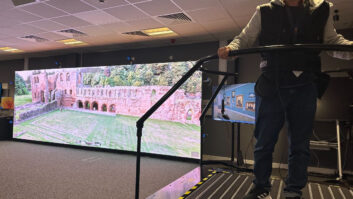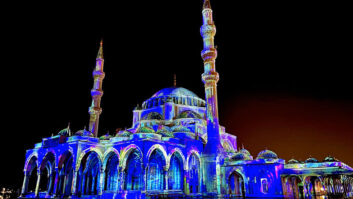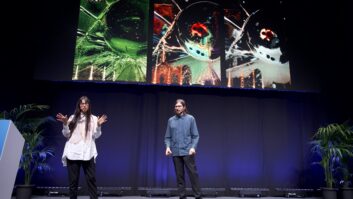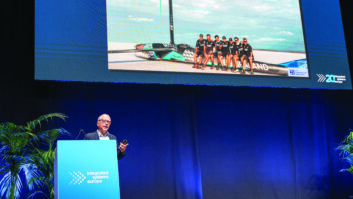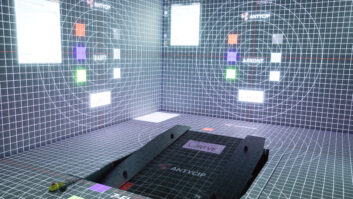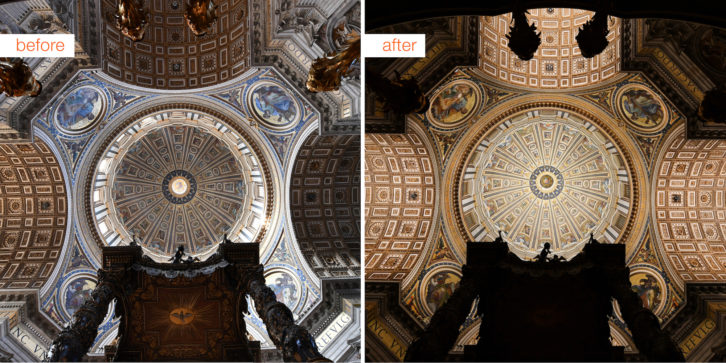
St Peter’s Basilica in the Vatican City is one of the largest and most important Catholic churches in the world, visited by about 27,000 worshippers and tourists a day.
The imposing sacred building is 190m long, the three aisles have a width of 58m, the central nave measures almost 46m at the highest point of the vault and the main dome is about 137m high. The sheer scale of this magnificent space is awe-inspiring at first glance and many visitors need to pause for a moment to take in its vast size.
The basilica also contains the largest mosaic in the world, with an area of approximately 10,000sqm, which, along with its numerous other marvellous works of religious art, now shine in new splendour, thanks to an innovative digital lighting system by Osram.
Following nearly 18 months of planning and the installation of a new LED lighting system, St Peter’s Basilica is now seen in a new light, with a total of 780 custom LED luminaires developed and manufactured for the project at Osram’s plant in Wipperfürth, Germany, equipped with 100,000 light-emitting diodes from the firm’s Regensburg factory and a ‘smart’ Osram lighting management system, also custom-built for the important project.
The illumination was digitally simulated in advance, enabling it to be implemented without any complex on-site test installations being required at the Vatican.
At present, the exact specs of the fixtures and control system are under wraps imposed by the Vatican, but the 780 luminaires are formed by three types of units: two flood models illuminating the vaults and a spot fixture illuminating the floor of the Basilica on special occasions.
Of the floods deployed, the majority are used to illuminate the main vaults at a height of 40m and the others (at a height of 24m) to illuminate the smaller vaults (octagons and small cupolas); the highest units installed are at a height of about 110 metres and the lowest at approximately 12 metres.
Shining light
As well as the mosaic and stucco decorations of Michelangelo’s Dome (completed by Giacomo della Porta in 1590), towering above the majestic baldacchin, the centre nave and the Chapel of the Pietà, which contains what is probably the world’s most famous sculpture of a religious subject (carved when Michelangelo was 24 years old, and the only one he ever signed), other wonders also able to be admired by the thousands of worshippers and visitors who flock to the Basilica are the decorations of the Clementine Chapel and the Chapel of Saints Michael and Petronilla.
With the new LED light, for example, the mosaics in the domes of the side aisles can now be seen down to the smallest detail. Numerous works of art previously shrouded in semi-darkness now shine in all their glory and, thanks to the new lighting concept, details that have never been visible before in the 500-year history of St Peter’s Basilica, details that even art experts were unaware of, can be seen, without disturbing reflections, in all their splendour and beauty for the first time since construction began in 1506.
The actual installation of the lighting fixtures on the cornices and the upper part of the trabeation (the construction system using beams/lintels and posts) was carried out by the Department of Technical Services of the Governorate of Vatican City State (headed by Reverend Rafael García de la Serrana Villalobos), meticulously following the strict regulations and measurements to be respected when such a historical revered building and its priceless artwork are involved, and also making important recommendations on the project.
“This project involved collaboration between the Technical Services of the Governorate and Osram. Together, they made up a unique team that succeeded, thanks to all its experience, in implementing the huge and unique project,” says De La Serrana Villalobos.
The church, which covers an area of around 22,000sqm, can be quickly and easily adapted to predefined lighting scenarios, thanks to the smart control system, also realised according to the precise requests of the Technical Services Department, and comprising two remote consoles located in areas of the Basilica under the surveillance of security staff.
The Department is also responsible for the creation or modification of the cues programmed on the control system, according to events held in the Basilica, and in co-ordination with the Master of Ceremonies for Papal liturgical celebrations and the Fabric of St Peter’s.
The origins of the Fabric of St Peter’s, the body currently managing all aspects of the Basilica, with respect to the preservation and decoration of the building and behaviour of employees and pilgrims entering the church, date back to 1523, when Pope Clement VII appointed a permanent committee of 60 experts with responsibility for building and administering the basilica, reporting directly to the Holy See.
Easy on the eye
As well as the luminaires being perfectly integrated into the architecture, thanks to their lines and compact dimensions, the LED illumination’s high spectral quality and efficient photometric distribution has significantly reduced glare and also enables worshipper to read without straining their eyes. Thanks to their efficiency, the number of luminaires also has been significantly reduced and, used with the digital control system, energy savings of up to 90% have been achieved compared with the old lighting.
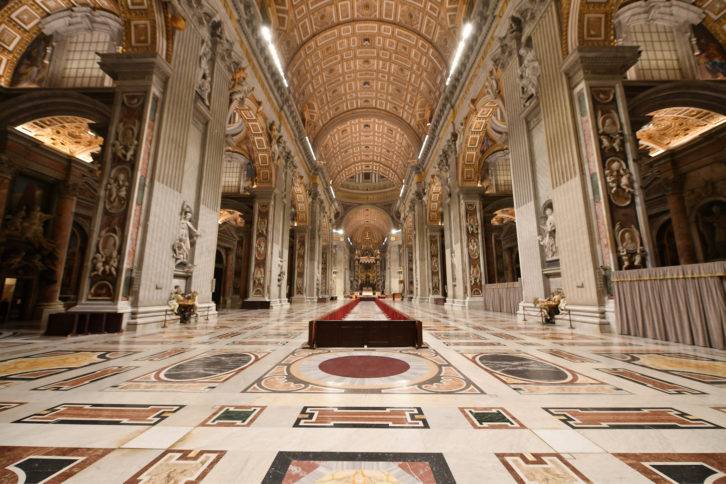
“We are very proud of this lighting masterpiece in St Peter’s Basilica,” said Olaf Berlien, CEO of Osram Licht AG. “The project demonstrates just how history and high tech can be combined in the best possible way by using the right expertise. More than 500 years of history are now being bathed in digitally controlled LED light.”
“This project provides a significant service, both to art lovers and those coming on pilgrimage to this symbol of Catholicism. We are pleased that a special light has been cast on this important location – thanks to the new illumination,” says S.E. Cardinal Giuseppe Bertello, president of the Governorate of the Vatican City State.
“The Basilica’s new lighting system fits in perfectly with the requirements for worship, prayer and celebration – particularly when the Holy Father is in attendance. At the same time, this ‘intelligent’ illumination has also allowed us to achieve another purpose: to be able to admire the architectural beauty of the Basilica,” says H.E. Cardinal Angelo Comastri, Archpriest of the Vatican Pope’s Basilica of St Peter.
Wide appeal
The new lighting system has also allowed to improve worldwide TV spectators’ viewing experience of transmissions from the Basilica now and in the future, as it enables television broadcasts from St Peter’s Basilica in VHD 4K and UHD 8K without any flickering or bias noise. Vatican Media had already run 8K tests at the 2019 Christmas Mass in St Peters and the latest additions to its 4K facilities was an upgrade to its OB8 truck, including Sony HDC-4300 4K/HD system cameras, XVS-8000 high-end 4K/3G/HD video switcher for IP and SDI and PWS-4500 live production server with IP technology.
Prior to the project for St Peter’s Basilica, LED technology from Osram had already ensured a dramatic change in worship and visiting experiences in several other key Vatican locations: the Sistine Chapel, St Peter’s Square and Raphael’s Rooms.
Inaugurated in 2014, Osram’s lighting for the Sistine Chapel (which is more than 500 years old, with the first mass in1483), which hosts some of the world’s most important paintings, including Michelangelo’s frescoes and works by famous artists of the Middle Ages, involved the installation of a total of 7,000 individual LEDs unobtrusively installed in the architecture.
Illuminance (around 50-100 lux) is much higher than before (previously 5-10 lux) and the system illuminates brightly while conserving the true colours, integrity and detail of wall and ceiling art. Pre-set lighting scenarios are programmed and selected according to celebration needs.
Two years later, Osram lighting was commissioned for the 48,000sqm St Peter’s Square, which hosts up to 400,000 visitors. A sustainable lighting concept with 70% energy saving that avoids light spill is ensured by 132 LED floodlights unobtrusively integrated into the architecture to ensure ‘Day bright’ 120 Lux for events, or “strolling” lighting under normal conditions.
In 2017, the four rooms known as the Raphael’s Rooms, which formed part of the apartment situated on the second floor of the Pontifical Palace chosen by Pope Julius II della Rovere and his successors as their residence, were also illuminated by Osram. The system was conceived and designed to illuminate and conserve true colours, integrity and detail of wall and ceiling art, which was created by Raphael and his school between 1508 and 1524.
Osram is also technical partner of the first permanent show in the Eternal City, staged in Via della Concilliazione, mid-way between St Peter’s Square and Castel Sant’Angelo. ‘The Last Judgement. Michelangelo and the Secrets of the Sistine Chapel’, is a 60-minute multimedia 9 million euro show to discover the Sistine Chapel, produced by Artainment Worldwide Shows with the scientific consultancy of the Vatican Museums.
